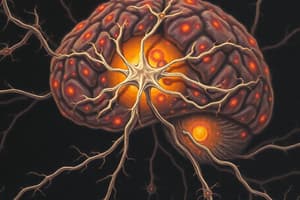Podcast
Questions and Answers
What is the primary function of neurotransmitters?
What is the primary function of neurotransmitters?
- To conduct electrical signals within a neuron
- To protect neurons from damage
- To travel across the synapse and affect target neurons (correct)
- To modulate blood flow in the brain
Glial cells have axons and dendrites like neurons.
Glial cells have axons and dendrites like neurons.
False (B)
What type of glial cell is known as the 'star cell' and provides physical support to neurons?
What type of glial cell is known as the 'star cell' and provides physical support to neurons?
Astrocyte
Neurotransmitters can be classified into _____ and _____ types.
Neurotransmitters can be classified into _____ and _____ types.
Match the following types of cells with their functions:
Match the following types of cells with their functions:
Which part of the nervous system is responsible for receiving sensory signals?
Which part of the nervous system is responsible for receiving sensory signals?
The sympathetic nervous system is primarily responsible for the 'Rest and Digest' response.
The sympathetic nervous system is primarily responsible for the 'Rest and Digest' response.
What is the role of afferent nerves in the nervous system?
What is the role of afferent nerves in the nervous system?
The _____ nervous system regulates the body’s internal environment.
The _____ nervous system regulates the body’s internal environment.
Match the following nervous system types with their functions:
Match the following nervous system types with their functions:
Flashcards are hidden until you start studying
Study Notes
Neurons and Glial Cells
- Neurons serve as the fundamental units of the nervous system, specialized for receiving, conducting, and transmitting electrochemical signals.
- Glial cells, often referred to as "forgotten cells," modulate neuron function, are smaller than neurons, and do not possess dendrites or axons.
Types of Neurons
- Neurons can be classified based on their function: sensory neurons, motor neurons, and interneurons.
Neuron Structure
- Dendrites receive signals, while axons transmit signals.
- The presynaptic terminal, or end bulb, contains neurotransmitters.
Neurotransmitters
- Chemical messengers released by neurons that cross synapses to influence target neurons.
- Types:
- Excitatory neurotransmitters increase the likelihood of action potential firing.
- Inhibitory neurotransmitters decrease the likelihood of action potential firing.
Glial Cell Types
- Astrocytes offer physical support to neurons and manage debris in the brain.
- Oligodendrocytes form the myelin sheath around CNS axons.
- Schwann cells produce myelin in the PNS and support axonal regeneration.
- Microglia act as the brain's immune cells, responding to injury or disease.
Membrane Potential
- Action potential represents a rapid reversal of membrane polarization (-70 mV to +50 mV).
- Resting potential is maintained around -70 mV, keeping neurons polarized.
Ionic Basis of Resting Potential
- Maintained by the sodium-potassium pump, which regulates ion exchange across the membrane.
Action Potential Stages
- Depolarization: Sodium ions enter the neuron, causing polarity to reverse.
- Repolarization: Potassium ions exit, restoring negative polarity.
- Refractory Phase: The neuron recovers and cannot fire again until ion balance is restored.
Conduction Mechanisms
- Action potentials travel down axons without decrement, faster in myelinated axons via saltatory conduction at nodes of Ranvier.
Synaptic Transmission
- Signals are transmitted chemically across synapses:
- Axodendritic: axon to dendrite.
- Axosomatic: axon to cell body.
- Axoaxonic: axon to another axon.
Neurotransmitter Release
- Neurotransmitters are synthesized, packaged, and stored in vesicles within the presynaptic terminal.
- Release via exocytosis, where vesicles fuse with the membrane, allowing neurotransmitters to enter the synaptic cleft.
Peripheral Nervous System (PNS) Divisions
- Somatic Nervous System: interacts with the external environment, sending sensory signals to the CNS and motor commands to skeletal muscles.
- Autonomic Nervous System (ANS): regulates internal environment, including sympathetic (fight or flight) and parasympathetic (rest and digest) responses.
Sympathetic vs. Parasympathetic
- Sympathetic Division: prepares the body for action by advocating energy expenditure, stimulates epinephrine release.
- Parasympathetic Division: promotes energy conservation and maintenance; has no effect on sweat glands.
Studying That Suits You
Use AI to generate personalized quizzes and flashcards to suit your learning preferences.





